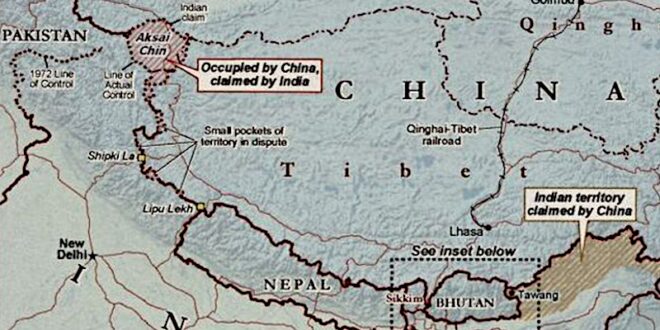On 23rd October 2021, the Standing Committee of the National People’s Congress adopted the People’s Republic of China’s (PRC) first dedicated law titled “Land Borders Law” which lays down provisions for border protection and integration of border areas. China currently has a 22,000-kilometre land border with 14 countries which is shared with Russia, India, Pakistan, Afghanistan, Bhutan, Myanmar, and Nepal, amongst others.
The new border law is to come into effect from 1 January 2022; it has 62 articles and seven chapters. The law broadly covers the following topics: –
a. Delimitation and survey of land borders
The new law lays down that the PRC shall set up boundary markers on all its land borders to clearly mark the border. The type of marker is to be decided in agreement with the relevant neighbouring state.
b. Management and defence of border areas
The People’s Liberation Army (PLA) and Chinese People’s Armed Police Force are assigned with the responsibility of maintaining security along the border. This responsibility includes cooperating with local authorities in combating illegal border crossings.
The law prohibits any party from indulging in any activity in the border area which would “endanger national security or affect China’s friendly relations with neighbouring countries”. This includes construction of any permanent buildings by any person without authorisation from the concerned authority. Even citizens and local organisations are mandated to protect and defend the border infrastructure, maintain security and stability of borders and co-operate with government agencies in maintaining border security.
Regarding the development of the border region, the law states that the PRC will take up education and propaganda in order to “solidify the sense of community of China, to promote the spirit of China, to defend the unity and territorial integrity of the country, strengthen citizens’ sense of the country and homeland security, and build a common spiritual home for the Chinese nation” amongst citizens in the border region. To this effect the law mandates to improve border public services and infrastructure, support their livelihoods and improve the living conditions.
Finally, the law provides for the border to be sealed in the event of a war, armed conflict, incidents which threaten the security of border residents such as biological and chemical accidents, natural disasters, and public health incidents.
c. International cooperation with neighbouring countries over border-related matters
On the topic of its border-sharing countries, the law lays down that the relations of PRC with these countries is to be based on principles of “equality and mutual benefit”. Further, the law provides for provisions for formation of joint committees, both civil and military, with the said countries to negotiate land border management and resolve border-related issues.
The law also stipulates that PRC should abide by the treaties on land borders that it has signed with the respective countries and all border issues are to be settled through negotiations.
A few days after adoption of the law, the Indian foreign ministry released a statement saying “China’s unilateral decision to bring about a legislation which can have implication on our existing bilateral arrangements on border management as well as on the boundary question is of concern to us, We also expect that China will avoid undertaking action under the pretext of this law which could unilaterally alter the situation in the India-China border areas,” and “the passage of this new law does not confer any legitimacy to the so-called China-Pakistan “Boundary Agreement” of 1963.” It is pertinent to note that India and Bhutan are the only two countries with which China does not have a finalised border agreement.
Some have stated that India’s condemnation of the new law was an overreaction as the law is in itself not controversial. PRC’s Foreign Ministry has further clarified that PRC would abide by the existing land boundary treaties it has signed. It is pertinent to note that the border governing policy was probably framed with factors other than the strained relationship with India in mind as well. After Afghanistan’s takeover by Taliban, China is concerned about Islamic extremists crossing into Xinjiang Uyghur Autonomous Region (XUAR) in order to destabilise the region. Another concern of the PRC would be to strengthen the land borders with Myanmar and Vietnam as illegal crossings from these countries reportedly contributed to the surge of COVID-19 cases in China.
However, the concern of the Indian government is a legitimate one if China’s recent aggressive behaviour towards it is any indicator. In 2020, China massed a huge number of troops to assert its claims over the Galwan Valley, Demchok, Depsnag and Pangong Lake in Ladakh and along the Sikkim-Tibet border. Both countries sustained several casualties during the conflict. Prior to that in 2017, India and China clashed in the Doklam, which is a disputed area between Bhutan and China where both countries were on the verge of all-out war.
What is even more concerning about the new border law is its timing and language. The law has come out in the backdrop of the 18-month long military stand-off along the Line of Actual Control (LAC) in Ladakh and failure of the 13th round of military talks between the two countries, which both countries blamed the other for..
The new law makes China’s borders “sacred and inviolable” and PLA being given the responsibility to protect these borders might act as a roadblock in any further negotiations in settlement of border disputes as the PLA might refuse to concede any of its actual or “claimed” land such as Arunachal Pradesh and Ladakh. There is also the possibility of the PRC limiting the water flow in the Brahmaputra or Yarlung Zangbo river which flows from China into India as the law calls for “ measures to protect the stability of cross-border rivers and lakes”. China might cite this provision in case of hydropower projects which may cause ecological disaster in India and call it a lawful action on its part.
Over the past few years, China has become more aggressive in its territorial claims over Indian territory.
Finally, the law calls for increased settlement of the civilian population and improved infrastructure along the border area. China has previously used the strategy of moving its “civil” population along the contested part of the LAC on the basis of which it claims rightful ownership. The new law might increase such instances and create further problems between the two countries.
Conclusion Practically , this new border law does not change the dynamics of the Sino-Indo relations to a large extent. Over the past few years, China has become more aggressive in its territorial claims over Indian territory. China has previously indulged in various measures which have escalated border issues with India to further its claims on disputed territories such as building roads near the border, using civilian population as an asset and the crossing of the LAC by the PLA into Indian territory on multiple occasions.
The law itself is not the main concern but the actions of the government and the army which have in the past interpreted and even flouted the established law as per their agenda. As Gautam Bambawale, a former Indian ambassador to China has stated, the law only states the obvious, it is the actions of the Chinese military and India’s reaction to them is what actually impacts the ground situation. Therefore, India’s reaction to the passing of the border law might have been over the top to begin with but in the next few years, India’s concern may well be proven right.
 Eurasia Press & News
Eurasia Press & News




